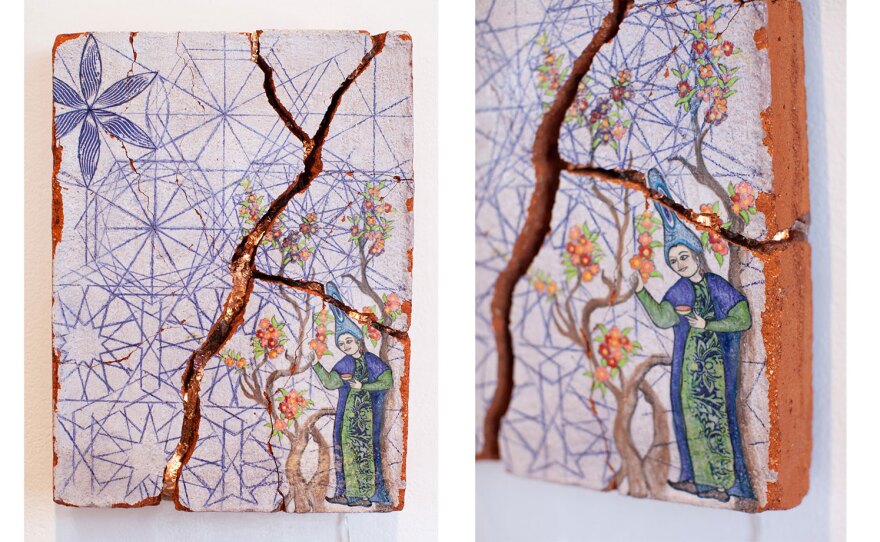This month, the San Diego Art Prize exhibition opens at Bread and Salt, and KPBS is spotlighting the four recipients of this year's prize — Hugo Crosthwaite, Panca, Perry Vasquez and Beliz Iristay.
Beliz Iristay began working with ceramics and clay during her education in her hometown of Izmir, Turkey.
"I was very curious with the many different techniques of ceramics," Iristay said. "I was into mold making and sculpting, and at the same time, learning the traditional Turkish arts, including miniature and calligraphy techniques, so now I use those also in my artwork."

Home is where the heart is
After she graduated, she worked at an international glass school in Istanbul — which is where she met her husband, artist Jamex De La Torre, half of the crossborder artist pair the De La Torre Brothers.
Part of the lure of this San Diego-Mexico border region, Iristay said, was love.
In 2003, after working in Mexico together for a year, as Iristay was set to return home to Turkey, De La Torre proposed, and the two started to live in both the United States and in Mexico.
She thinks of all three regions as home now, and each adds a certain tension and influence in her work.
"The idea of home has become much more theoretical over the years, and more grounded and rooted in the idea of people, language, values and traditions. Things that are movable in ways that a house and a physical land is not," Iristay explained. "So you can see in my work that I examined this, this relocation and movements, and I collect the subject materials for my work from the traditions, politics and gender issues of these three countries that I live in."

Material rule breaking
"I am very blended in the way I live, so I can mirror that into my work. You can see the blend," Iristay said. Her works are a sort of cultural mixtures of not just subject matter but also materials, histories and forms.
For example, she found local brick makers in Mexico for materials — a raw and primitive component — and using this rough clay in the intricate and fragile slip casting techniques she's learned in the United States. Her background of making ceramics in the Turkish tradition ultimately results in a combination of influence and rule-breaking in her work.
"My background is very specific, all about the rules of making ceramics with the Turkish tradition, the traditional Turkish ceramics that I used to study. You have all the rules of how to shape the clay, how to fire the clay, and the painting has to be perfect, very very detailed miniature paintings. So I am trying to break out of those over the years, and combine all these techniques together," Iristay said.

'Cundina': Women's voices
Along with identity, place, history and home, much of Iristay's work also deals with gender. A work that will be part of the San Diego Art Prize exhibition in two versions is "Cundina." One version, an older work, is a grid of porcelain tiles, each with castings of her lips. A new version of the piece includes lips set into a rough brick.
The idea of women being considered "contemptous" is a common issue in Turkey, Iristay said, and one of the reasons she wanted to use her own mouth as a literal, tangible part of her work.
"Cundina" is inspired by a traditional Mexican gathering of women Iristay learned about when she first began working in Mexico.
"It's been going on centuries. Centuries and centuries. And interestingly, when I found out through my ceramic class ladies — I gave workshops over there to the locals — they would keep telling me, 'Okay, what are we doing for cundina this week?'" Iristay said.
Her students told her that for over 25 years, they've been getting together several times a month to share a meal and raise funds — either for a member of the group in need or to support charities — and also as a way to build community.
"They get together, they eat, they talk. It's complete therapy in a way. It makes them really strong," Iristay said.
The cundina in Mexico reminded her of a similar philanthropic gathering her mother hosted in Turkey, and it amazed her that the philosophy bridged different cultures from opposite corners of the globe.
She tagged along to her students' cundina in Mexico and filmed it, and the resultant documentary video is also projected over the wall panel. Made of hundreds of her casted lips, the work reflects the power and voice women can find in numbers.
Stylizing parts of the feminine body into a repeating artistic motif hearkens back to Turkish traditions — this originated, Iristay said, as a way to represent women without actually depicting a female figure.
RELATED: 5 Works Of Art To See In San Diego In August
Iristay will also show several other works in the San Diego Art Prize exhibition, including brick works and wall tiles that explore the complicated politics of gender and sex.
2021 San Diego Art Prize Exhibition:
On view at Bread and Salt Oct. 9, 2021 - Dec. 31, 2021.
Featuring work by 2021 prize recipients Beliz Iristay, Hugo Crosthwaite, Perry Vasquez and Panca.
Gallery hours: Tuesday through Saturday, 11 a.m. - 4 p.m.
Opening reception: Oct. 9 from 5-8 p.m.
At the reception, the band The Color Forty Nine will perform and project the music video they created with Crosthwaite.






